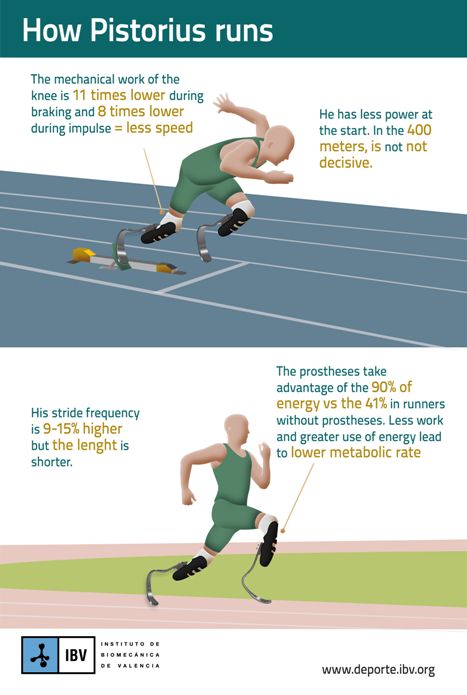Does Oscar Pistorius have an unfair advantage over other Olympic athletes?
8 August updated 3 Sept 2012
The Institute of Biomechanics in Valencia has reviewed the advantages and disadvantages that a prosthetic leg could give to a runner such as Oscar Pistorius.
He reached the semi-finals of the London 2012 Olympic 400m competition, coming eighth. He became the first amputee sprinter to compete in the Olympics.
Oscar Pistorius was embroiled in further controversy on 2 September after he was beaten in the Paralympics T44 200m final by Brazilian Alan Oliveira. In a TV interview after the race Pistorius claimed the legs of winner Alan Oliveira were too long, giving him an unfair advantage. He subsequently apologised for the timing of his comment, but has requested a meeting with the International Paralympic Committee to discuss the length of prosthetic legs (blades) allowed by the rules.
The selection of Pistorius in the Olympics reopened the debate whether he should compete with other athletes. In both, World Athletics Osaka 2007 and 2008 Olympic Games, the IAAF banned him participating claiming that his prosthetic legs gave a biomechanical advantage over its opponents.
However, also in 2008, the Court of Arbitration for Sport ruled that Pistorius could participate in the IAFF competitions because the biomechanical studies carried out had not made clear whether Pistorius had a complete advantage.
The Institute of Biomechanics (IBV) considers that this controversy stems from the lack of technical regulation. First, it is necessary that official organizations make clear in each case whether they are allowed to participate in non-Paralympic competitions. The first question to answer must be can an athlete with prostheses who reaches the qualifying standards participate in official athletics competitions? If the answer is yes, then the organizations need to assess whether the prostheses are suitable for competition.
It appears that this first question has been answered in the case of Pistorius, and the core of the current conflict is to determine whether his prostheses provide an advantage over other athletes.
The response to this conflict has a great complexity as it is very difficult to assess the balance between the advantages and disadvantages of the prostheses. Biomechanical studies have shown that Pistorius obtains advantages in some aspects such as increased energy return, but also has disadvantages such as a decreased use of force.
At this point, there is evidence of the need for rules to decide if it is or is not possible to use a specific prosthesis. This policy should dictate the biomechanical properties of the prostheses, and establish appropriate ranges they must meet to make their use legal.
This same problem happened in other disciplines where rules have been brought in to solve a conflict. Well known examples are the establishment of a minimum weight for bicycles by the UCI (International Cycling Union) or the annual need for approval of swimsuits by FINA (International Swimming Federation) in the evaluation of parameters such as buoyancy or permeability.
While a clear technical regulation is not developed, the controversy and doubts will exist regarding the legitimacy of the participation of Oscar Pistorius in Olympic games.
How Pistorius runs
US and German researchers have shown in various studies in 2008 and 2009 the following aspects of the biomechanics in how Pistorius runs.
First, Pistorius has a greater length of stride, but offsets this disadvantage by performing a greater stride frequency.
The mechanical work of the knee, understood as the force that can be applied to the knee in its displacement, is smaller than the rest of runners. Putting numbers to this result, mechanical work applied by Pistorius was 11 times lower in the braking phase support, and 8 times less in the propulsive phase of walking. This means obtaining a 22% less vertical reaction force than runners with normal limbs, resulting in a lower speed rate.
During running, the ground returns to the athletes energy that they are able to reuse in a percentage useful to keep running. 400m runners are able to reuse 41% of this energy. On the contrary, thanks to metal blades, Pistorius achieves a 90% reuse. That difference of 49% less energy loss allows Pistorius to sprint as fast as a runner without a prostheses with a lower metabolic cost.
In the first step of the start is when the performance of Pistorius may be much less than its opponents. At this point, as he is unable to take the energy return of previous steps, it is essential to generate impulse with his muscles. This impulse is shown to be lower than the other runners. This disadvantage in the start is more influential during the shorter races. In the 100m has a great influence, while in 400m is usually not critical to the final result of the race.

More information
Get the latest information about biomechanics with books from Amazon>>